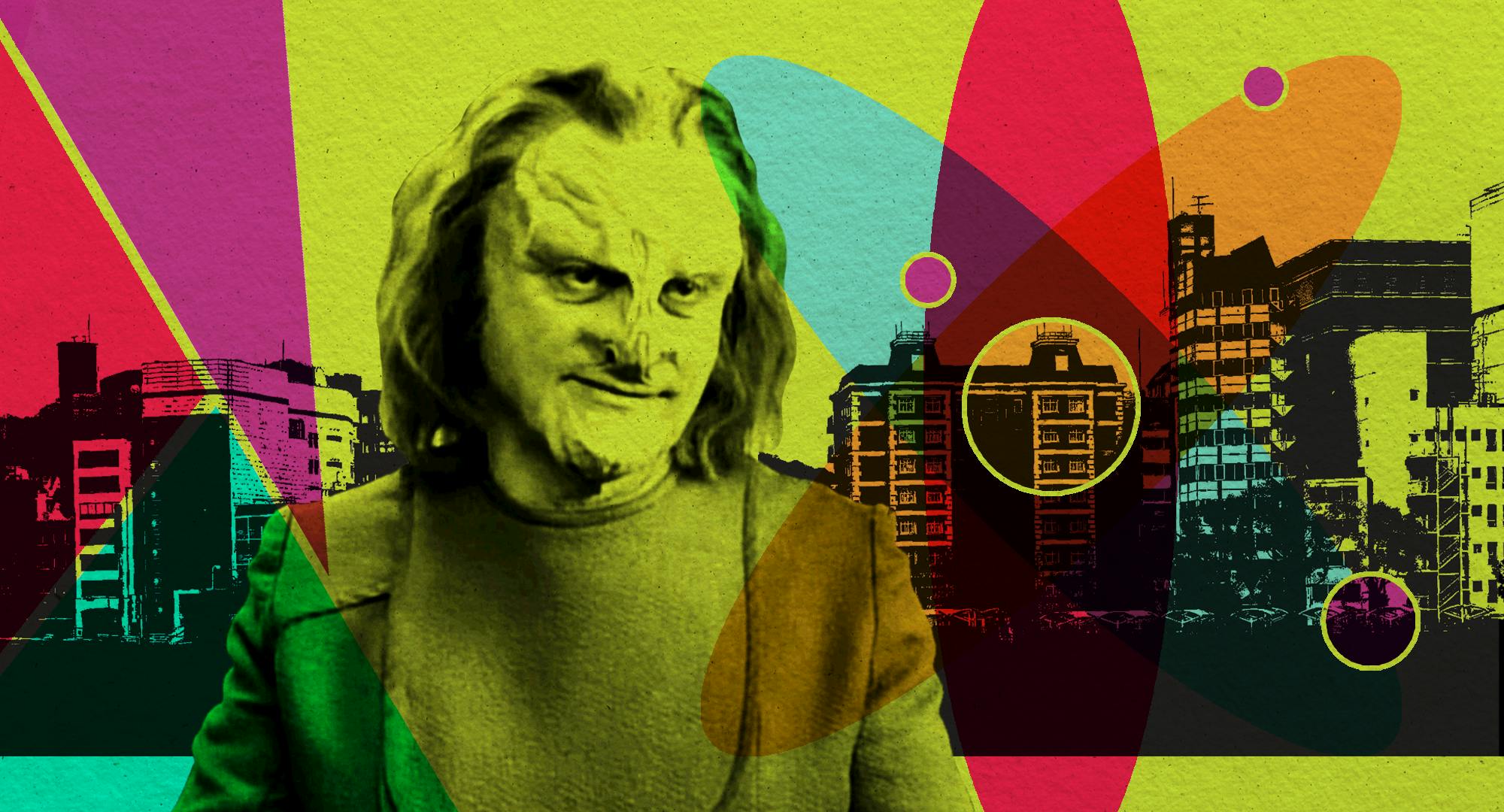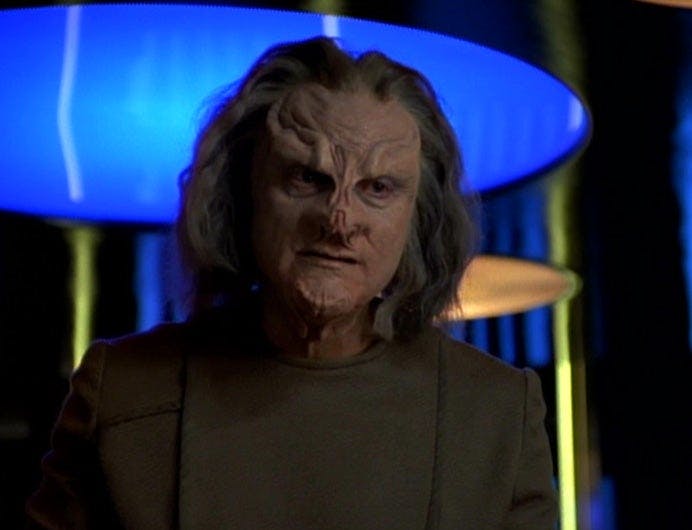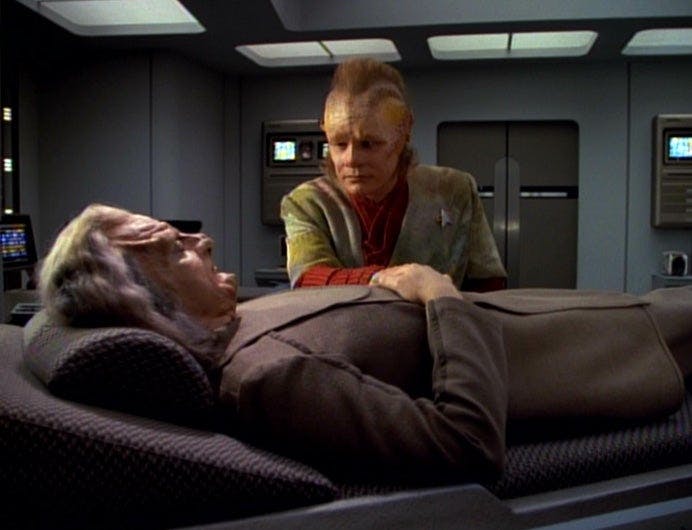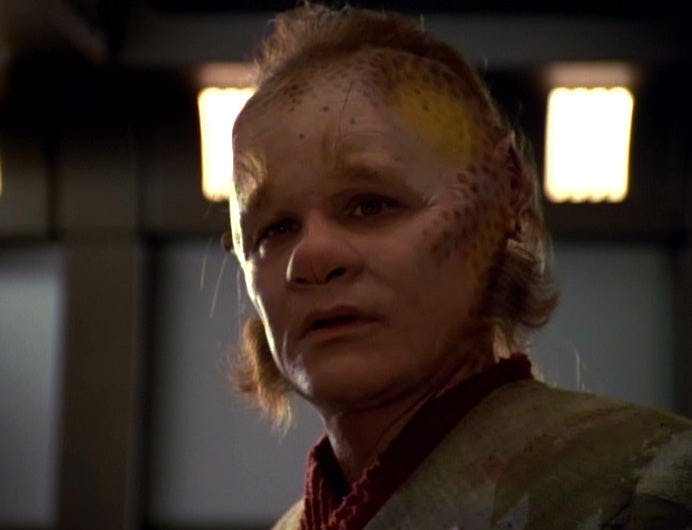Published Aug 6, 2020
Jetrel and the Destroyers of Worlds
75 years on from Hiroshima, Duncan Barrett looks at how Voyager reimagined the dropping of the atom bombs in the episode “Jetrel.”

StarTrek.com | Shutterstock
When J. Robert Oppenheimer, the scientist in charge of the Manhattan Project during World War Two, witnessed the first atomic test in the New Mexico desert, a line from Hindu scripture popped into his head: “If the radiance of a thousand suns were to burst at once into the sky, that would be like the splendor of the mighty one.”
Fifty years later, Star Trek: Voyager screenwriter Kenneth Biller echoed Oppenheimer’s quotation from the Bhagavad Gita in the first-season episode “Jetrel”. The eponymous Haakonian scientist, whose Metreon Cascade caused the destruction of a Talaxian moon fifteen years previously, tells Neelix thoughtfully, “The day when we tested the Cascade, when I saw that blinding light, brighter than a thousand suns, I knew at that moment exactly what I had become.”
Exactly what Jetrel has become is, in some ways, the core concern of the episode. Is the man whose complex technical accomplishment led to the death of 300,000 Talaxians — among them Neelix’s entire family — a monster, or just a scientist pursuing the inevitable advancement of knowledge? To some extent, “Jetrel” is careful to avoid fully endorsing either viewpoint, even suggesting that Neelix’s anger towards the architect of his family’s destruction may be a form of misplaced guilt for his own “cowardice” in refusing to fight. But in using those words “what I had become”, Biller teases Oppenheimer’s more famous quotation from the Bhagavad Gita, given in a televised interview twenty years after the dropping of the bombs on Hiroshima and Nagasaki: “Now I am become Death, the Destroyer of Worlds.”

StarTrek.com
For Jetrel, the allusion is horrifically accurate – his weapon has quite literally destroyed the world of Rinax, still hidden beneath a swirling cloud of Metreon particles when Voyager visits the Talaxian system a decade and a half later. Neelix vividly recalls witnessing the original attack:
“[A] bright flash cut across the sky. It was so blinding that people threw themselves to the ground. […] Then we all looked up to see where the flash had come from, but the sky seemed oddly empty. It took most of us a few seconds to realise it was because Rinax was gone. Of course, the moon was still there. We just couldn't see it because of that Metreon cloud.”
75 years ago, on August 6, 1945, when the first atom bomb was dropped on the Japanese city of Hiroshima, the bright flash of light and the characteristic mushroom cloud that followed it were visible many miles away from ground zero. Up to 80,000 people were killed in a matter of moments, followed three days later by another 40,000 when a second bomb was dropped on Nagasaki. Even then, it wasn’t until August 15 that Emperor Hirohito formally announced the Japanese surrender. (The Talaxians, by contrast, took less than 24 hours to surrender to the Haakonians.)
The legacy of America’s use of the two atom bombs is a complex and anguished one, and Voyager’s contribution to the 50th-anniversary commemorations that took place around the world in 1995 is both thoughtful and humane. A conscious attempt to repeat the success of Deep Space Nine’s acclaimed episode “Duet” (which, like “Jetrel”, occupies the penultimate spot in the show’s freshman season), it took a similarly weighty topic – in this case Hiroshima rather than the Holocaust – and crafted an intimate personal drama between victim and perpetrator, carefully subverting audience assumptions about responsibility and guilt.
Both episodes, interestingly, entwine the moral legacy of these dark historical moments with lingering biological traces. In “Duet” the Kalla-Nohra disease is caused by a mining accident in a Cardassian labor camp, while in “Jetrel” the blood disease metremia results from exposure to Metreon isotopes, and – in another echo of the atomic science underpinning the Manhattan Project – causes fission at the cellular level.
For Voyager writer Kenneth Biller, researching the radiation poisoning that occurred after the Hiroshima and Nagasaki attacks was the most grueling part of working on the episode. “I did research and saw footage of people with radiation poisoning,” he told Cinefantastique the following year. “I was depressed for weeks while writing it.”
Biller’s decision to have Jetrel die, rather poetically, of the disease caused by his own invention was not without precedent in Los Alamos. Two scientists who worked on the Manhattan Project died from exposure to radiation during their time there. On August 21, 1945, just days after the Japanese surrender, the American physicist Harry Daghlian accidentally dropped a brick onto a plutonium core, and exactly nine months later the Canadian physicist Louis Slotin was exposed to a burst of hard radiation from the same core during a failed demonstration. Daghlian lasted 25 days before succumbing to acute radiation poisoning, while Slotin was dead in a little over a week.

StarTrek.com
For the most part, however, the legacy of radiation exposure was one visited on the Japanese civilians who survived the initial blasts of August 1945 but later succumbed to the bombs’ invisible after-effects. By the end of 1945, both cities had lost around a third of their populations, while cancer and birth defects would continue to plague survivors in the months and years to come.
Oppenheimer, meanwhile, did not die as a result of his own research – the lung cancer that killed him was, rather, the result of forty years of heavy smoking. Yet when Star Trek’s writers have used him as a template, the resulting characters always seem to be undone by their morally tainted discoveries. When Enterprise introduced the Xindi scientist Degra – another character explicitly modeled on Oppenheimer – it came as no surprise that, despite an intricate redemption arc, he ended up with a knife in his chest. His moral crime, creating a weapon that killed 7 million people, was too great a sin to be forgiven in the uncompromising court of storytelling.
Such narrative gestures may serve to deal with the cultural guilt that surrounds events such as the dropping of the atomic bombs. For the same reason, the popular image of Oppenheimer today tends to be of an anguished, guilt-stricken scientist, appalled by the horror he has unleashed on the world. In reality, Oppenheimer’s feelings were much more ambivalent. While he opposed the nuclear proliferation that took place during the Cold War and worried about the role his work might end up playing in a cataclysmic doomsday scenario, he maintained that dropping the bombs during World War Two was not only necessary but morally justified.
In some ways, Ma’Bor Jetrel walks a similarly ambivalent path, stalwartly refusing the labels that Neelix tries to pin on him. Although even his wife can see him only as a monster – an echo, perhaps, not of Oppenheimer’s experience but that of the German scientist Fritz Haber, whose wife Clara killed herself after the first use of his Chlorine gas during the first world war – Jetrel maintains he was just a scientist following an inevitable path of discovery. “It's good to know how the world works,” he tells Neelix. “It is not possible to be a scientist unless you believe that all the knowledge of the universe and all the power that it bestows is of intrinsic value to everyone, and one must share that knowledge and allow it to be applied, and then be willing to live with the consequences.”

StarTrek.com
And yet, as much as Jetrel has learned to live with his conscience, he is also a man on a mission of redemption, albeit one doomed to failure. In the world of Star Trek, the slim possibility of bringing the dead back to life, however remote, is irresistible, and enough to inspire the final great effort of his professional life.
Not so, of course, for real-life destroyers of worlds, who must make peace with the terrible human cost of their discoveries, without even the slim possibility of a magical science-fiction reprieve.
Duncan Barrett (he/him, @BarrettsBooks) is the co-author of Star Trek: The Human Frontier and the host of Primitive Culture, a TrekFM podcast about Star Trek and history.
Please consider doing what you can to help Lebanon after the devastating August 4 explosion in the city of Beirut. More information available here.

